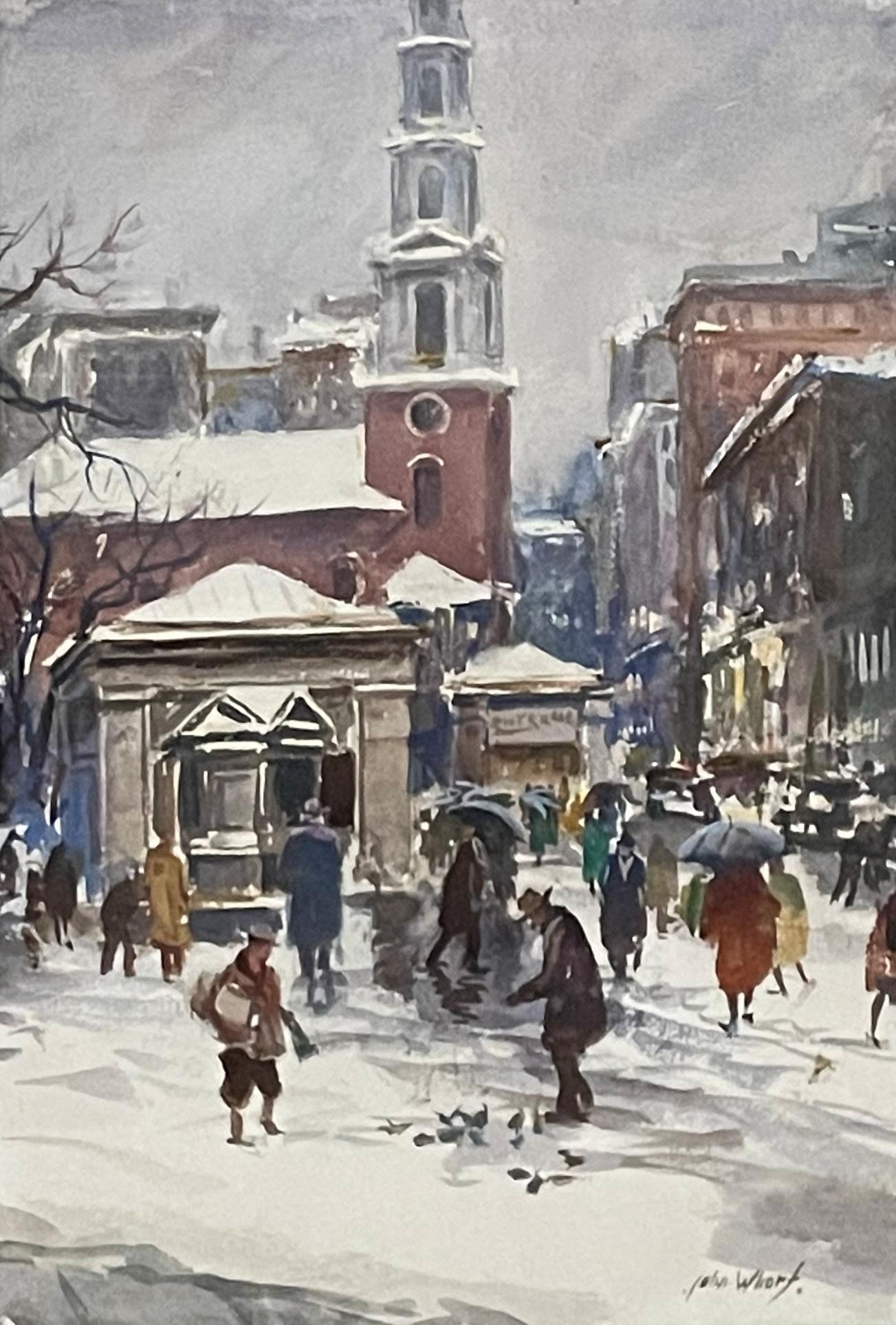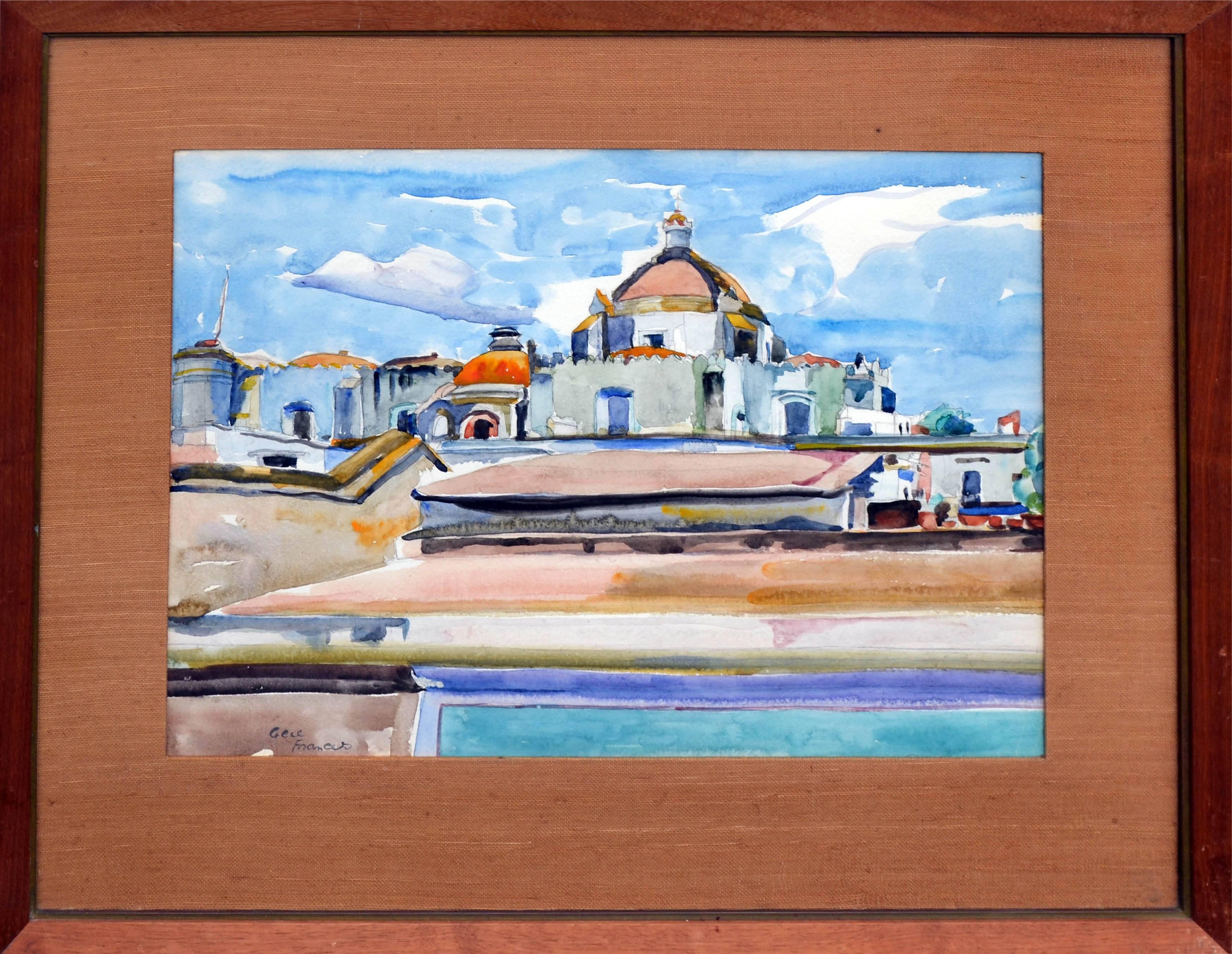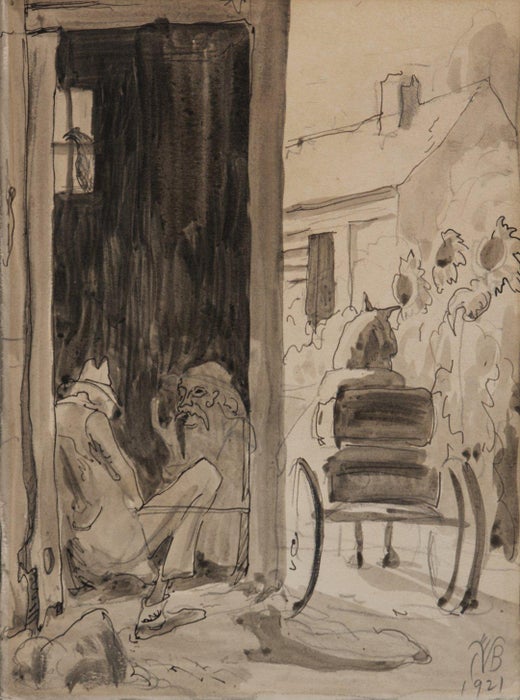Charles E. BurchfieldStudy for Skunk Cabbage, Watercolor Painting by Charles Burchfield 19311931
1931
About the Item
- Creator:Charles E. Burchfield (1893-1967, American)
- Creation Year:1931
- Dimensions:Height: 23 in (58.42 cm)Width: 34 in (86.36 cm)
- Medium:
- Movement & Style:
- Period:
- Condition:
- Gallery Location:Long Island City, NY
- Reference Number:1stDibs: LU466367842
Charles E. Burchfield
Born in Ashtabula Harbor, Ohio, Charles Burchfield became known as a town-landscape painter of middle-western America, and his paintings, drawings and prints have had much influence on succeeding generations of artists. He has also been described as a social critic, naturalist, and transcendental visionary whose sensitivities infuse his artwork. Of his impact on American art, Matthew Baigell wrote: "Few American artists have ever responded with such passion to the landscape or have made it such a compelling repository as well as mirror of their intimate feelings."
In addition to his painting, Burchfield was a teacher at the Art Institute of Buffalo from 1949 to 1952 and at the University of Buffalo from 1950 to 1952.
Burchfield's career can be divided into three phases. The first is landscapes based on childhood memories and fantasies and ended about 1918; the second, from 1918 to 1943, is Social Realism, including “grimy streets and rundown buildings of the eastern Ohio area,” and the third phase is a return to subject matter of his childhood and the “investing them with a kind of ecstatic poetry.” (Biagell 54)
Throughout Burchfield's career, watercolor was his preferred medium. Knowledge of Oriental art influenced him to use simple forms.
Burchfield spent his youth in Salem, Ohio, where he developed a keen interest in art and nature and was intensely aware of woodland sounds and noises. In 1912, he decided to become a painter and enrolled in the Cleveland School of Art, where his most influential teacher was Henry Keller. Another major Ohio influence on his painting was William Sommer, leader of the modernist movement in the Cleveland area. He introduced Burchfield to experimental watercolor techniques and color theory, and Burchfield began attending sessions of the Kokoon Club, organized by Sommer and William Zorach to promote avant-garde art. In 1917, he developed a shorthand of abstractions of various shapes and moods, and he also began painting small houses that appeared to be haunted.
Burchfield served in World War I from 1918 to 1919, and served as sergeant in the Camouflage Corps, camouflaging artillery pieces. In 1921, he moved to Buffalo, New York, where until 1929, he worked as a wallpaper designer for the M.H. Birge and Sons Wallpaper Company. From that time, living the remainder of his life in Buffalo, he devoted himself full time to fine-art painting that ranged from rather sentimental depictions to abstraction in the 1960s.
In the 1920s, Burchfield moved away from what he perceived as an overactive imagination and did studies of architecture of Midwestern streets. This subject matter of the realities of the man-made world was influenced by his reading of Winesburg, Ohio: A Group of Tales of Ohio Small-Town Life by Sherwood Anderson, and playing off those themes he reflected a debunking of the heartland sentimentality by so-called sophisticated, more worldly critics. Then in 1943, he returned to his earlier style which he explained was a "necessary diversion" from the aftermath of World War II.
Once more Burchfield began to explore the landscape of his youth, and, using a less realistic style, became almost mystical in his expressions of nature including seasonal changes, and forest sounds, which he depicted with quivering brushstrokes. "His last paintings are filled with chimerical creatures — butterflies and dragonflies from another world." (Baigell 55)
The largest single collection of Burchfield’s work is at the Burchfield-Penney Art Center in Buffalo, New York, and includes his watercolors, prints, oil paintings and preliminary sketches for both paintings and wallpaper designs. In 1997, a major retrospective of his work was held at the National Museum of American Art in Washington, D.C. and was organized by the Columbus Museum of Art.
Find original Charles Burchfield paintings and prints on 1stDibs.
(Biography provided by Gallery of the Masters)
- ShippingRetrieving quote...Ships From: Long Island City, NY
- Return PolicyA return for this item may be initiated within 7 days of delivery.
- On the Steps of Santa Prisca, Taxco Mexico - Gouache by Franklin Moss HamiltonBy Franklin Moss HamiltonLocated in Long Island City, NYArtist: Frank Moss Hamilton, American (1930 - 1999) Title: On the Steps of Santa Prisca, Taxco Mexico Year: circa 1960 Medium: Gouache On Paper, signed l.r. Size: 23.5 x 35.5 in. (59...Category
1960s American Impressionist Landscape Paintings
MaterialsGouache
- The "Cannonball", Locomotive Watercolor by Reginald MarshBy Reginald MarshLocated in Long Island City, NYArtist: Reginald Marsh, American (1898 - 1954) Title: The "Cannonball" Year: 1936 Medium: Watercolor on Paper, signed, titled, and dated l.r. Size: 16.5 in. x 22.5 in. (41.91 cm x 57...Category
1930s American Impressionist Landscape Paintings
MaterialsWatercolor
- Acapulco Beach Scene, Watercolor by Dong KingmanBy Dong KingmanLocated in Long Island City, NYArtist: Dong Moy Chu Kingman, Chinese/American (1911 - 2000) Title: Acapulco Beach Scene I Year: 1968 Medium: Watercolor, signed and dated l.r. Size: 10.5 x 18 on 13.5 x 20.5 inches ...Category
1960s American Impressionist Landscape Paintings
MaterialsWatercolor
- Farm Lane, Watercolor Painting by Ben BennBy Ben BennLocated in Long Island City, NYArtist: Ben Benn, Russian/American (1884 - 1983) Title: Farm Lane Medium: Watercolor on Paper, signed l.r. Size: 18.5 x 12 in. (46.99 x 30.48 cm) Frame Size: ...Category
1920s American Impressionist Landscape Paintings
MaterialsWatercolor
- Pontevecchio TwilightBy Kerry HallamLocated in Long Island City, NYA glowing pink impression of the city of Firenze as seen from above. The painting centers mostly on the Ponte Vecchio, a covered bridge filled with shops crossing the Arno River. Cit...Category
Early 2000s American Impressionist Landscape Paintings
MaterialsCanvas, Acrylic
- "City Street, " Oil on Board, circa 1930By Raphael SoyerLocated in Long Island City, NYArtist: Raphael Soyer, American (1899 - 1987) Title: City Street Year: circa 1930 Medium: Oil on Board, signed verso Size: 20 in. x 13.75 in. (50.8 cm x 34.93 cm) Frame Size: 26 x 20...Category
1930s American Impressionist Landscape Paintings
MaterialsOil, Board
- "Train Station, " Max Kuehne, Industrial City Scene, American ImpressionismBy Max KuehneLocated in New York, NYMax Kuehne (1880 - 1968) Train Station, circa 1910 Watercolor on paper 8 1/4 x 10 1/4 inches Signed lower right Provenance: Private Collection, Illinois Max Kuehne was born in Halle, Germany on November 7, 1880. During his adolescence the family immigrated to America and settled in Flushing, New York. As a young man, Max was active in rowing events, bicycle racing, swimming and sailing. After experimenting with various occupations, Kuehne decided to study art, which led him to William Merritt Chase's famous school in New York; he was trained by Chase himself, then by Kenneth Hayes Miller. Chase was at the peak of his career, and his portraits were especially in demand. Kuehne would have profited from Chase's invaluable lessons in technique, as well as his inspirational personality. Miller, only four years older than Kuehne, was another of the many artists to benefit from Chase's teachings. Even though Miller still would have been under the spell of Chase upon Kuehne's arrival, he was already experimenting with an aestheticism that went beyond Chase's realism and virtuosity of the brush. Later Miller developed a style dependent upon volumetric figures that recall Italian Renaissance prototypes. Kuehne moved from Miller to Robert Henri in 1909. Rockwell Kent, who also studied under Chase, Miller, and Henri, expressed what he felt were their respective contributions: "As Chase had taught us to use our eyes, and Henri to enlist our hearts, Miller called on us to use our heads." (Rockwell Kent, It's Me O Lord: The Autobiography of Rockwell Kent. New York: Dodd, Mead and Co., 1955, p. 83). Henri prompted Kuehne to search out the unvarnished realities of urban living; a notable portion of Henri's stylistic formula was incorporated into his work. Having received such a thorough foundation in art, Kuehne spent a year in Europe's major art museums to study techniques of the old masters. His son Richard named Ernest Lawson as one of Max Kuehne's European traveling companions. In 1911 Kuehne moved to New York where he maintained a studio and painted everyday scenes around him, using the rather Manet-like, dark palette of Henri. A trip to Gloucester during the following summer engendered a brighter palette. In the words of Gallatin (1924, p. 60), during that summer Kuehne "executed some of his most successful pictures, paintings full of sunlight . . . revealing the fact that he was becoming a colorist of considerable distinction." Kuehne was away in England the year of the Armory Show (1913), where he worked on powerful, painterly seascapes on the rocky shores of Cornwall. Possibly inspired by Henri - who had discovered Madrid in 1900 then took classes there in 1906, 1908 and 1912 - Kuehne visited Spain in 1914; in all, he would spend three years there, maintaining a studio in Granada. He developed his own impressionism and a greater simplicity while in Spain, under the influence of the brilliant Mediterranean light. George Bellows convinced Kuehne to spend the summer of 1919 in Rockport, Maine (near Camden). The influence of Bellows was more than casual; he would have intensified Kuehne's commitment to paint life "in the raw" around him. After another brief trip to Spain in 1920, Kuehne went to the other Rockport (Cape Ann, Massachusetts) where he was accepted as a member of the vigorous art colony, spearheaded by Aldro T. Hibbard. Rockport's picturesque ambiance fulfilled the needs of an artist-sailor: as a writer in the Gloucester Daily Times explained, "Max Kuehne came to Rockport to paint, but he stayed to sail." The 1920s was a boom decade for Cape Ann, as it was for the rest of the nation. Kuehne's studio in Rockport was formerly occupied by Jonas Lie. Kuehne spent the summer of 1923 in Paris, where in July, André Breton started a brawl as the curtain went up on a play by his rival Tristan Tzara; the event signified the demise of the Dada movement. Kuehne could not relate to this avant-garde art but was apparently influenced by more traditional painters — the Fauves, Nabis, and painters such as Bonnard. Gallatin perceived a looser handling and more brilliant color in the pictures Kuehne brought back to the States in the fall. In 1926, Kuehne won the First Honorable Mention at the Carnegie Institute, and he re-exhibited there, for example, in 1937 (Before the Wind). Besides painting, Kuehne did sculpture, decorative screens, and furniture work with carved and gilded molding. In addition, he designed and carved his own frames, and John Taylor Adams encouraged Kuehne to execute etchings. Through his talents in all these media he was able to survive the Depression, and during the 1940s and 1950s these activities almost eclipsed his easel painting. In later years, Kuehne's landscapes and still-lifes show the influence of Cézanne and Bonnard, and his style changed radically. Max Kuehne died in 1968. He exhibited his work at the National Academy of Design, the Art Institute of Chicago, the Carnegie Institute in Pittsburgh, the Memorial Art Gallery of the University of Rochester, and in various New York City galleries. Kuehne's works are in the following public collections: the Detroit Institute of Arts (Marine Headland), the Whitney Museum (Diamond Hill...Category
1910s American Impressionist Landscape Drawings and Watercolors
MaterialsPaper, Watercolor
- "Monhegan Island, Maine, " Edward Dufner, American Impressionism Landscape ViewBy Edward DufnerLocated in New York, NYEdward Dufner (1872 - 1957) Monhegan Island, Maine Watercolor on paper Sight 16 x 20 inches Signed lower right With a long-time career as an art teacher and painter of both 'light' and 'dark', Edward Dufner was one of the first students of the Buffalo Fine Arts Academy to earn an Albright Scholarship to study painting in New York. In Buffalo, he had exchanged odd job work for drawing lessons from architect Charles Sumner. He also earned money as an illustrator of a German-language newspaper, and in 1890 took lessons from George Bridgman at the Buffalo Fine Arts Academy. In 1893, using his scholarship, Dufner moved to Manhattan and enrolled at the Art Students League where he studied with Henry Siddons Mowbray, figure painter and muralist. He also did illustration work for Life, Harper's and Scribner's magazines. Five years later, in 1898, Dufner went to Paris where he studied at the Academy Julian with Jean-Paul Laurens and privately with James McNeill Whistler. Verification of this relationship, which has been debated by art scholars, comes from researcher Nancy Turk who located at the Smithsonian Institution two 1927 interviews given by Dufner. Turk wrote that Dufner "talks in detail about Whistler, about how he prepared his canvasas and about numerous pieces he painted. . . A great read, the interview puts to bed" the ongoing confusion about whether or not he studied with Whistler. During his time in France, Dufner summered in the south at Le Pouleu with artists Richard Emil Miller...Category
Early 20th Century American Impressionist Landscape Drawings and Waterco...
MaterialsPaper, Watercolor
- "River Landscape" Julian Alden Weir, American Impressionist, Connecticut SceneBy Julian Alden WeirLocated in New York, NYJulian Alden Weir River Landscape Signed lower left Watercolor on paper 9 x 11 1/2 inches Provenance: Kraushaar Galleries, New York Sotheby's Parke Bernet, New York, 1965, Lot 27 E....Category
Late 19th Century American Impressionist Landscape Drawings and Watercolors
MaterialsWatercolor, Paper
- "Park Street Church, Boston, " John Whorf Impressionist Watercolor WPA CityscapeBy John WhorfLocated in New York, NYJohn Whorf (1903 - 1959) Park Street Church, Boston, circa 1930-45 Watercolor on paper 21 x 15 inches Signed lower right Housed in its original frame Provenance: Milch Gallery, New ...Category
1930s American Impressionist Landscape Drawings and Watercolors
MaterialsWatercolor, Paper
- Mid Century Mexico Cathedral Watercolor LandscapeBy Eugenia Frances Baker McComasLocated in Soquel, CAVibrant Mexico Cathedral by Eugenia Francis Baker McComas (American, 1886-1982). Presented in a wooden frame. Shipped without glass. Signed "Gene Frances" lower left. Image size, 15"H x 19"W. Eugenia Frances Baker McComas was born in San Francisco, California on September 6, 1886. She came from a family of journalists where her father Joseph Eugene Baker was the editor of the Alta Californian, now San Francisco Examiner, and her mother was a theater critic for The Oakland Tribune. Eugenia also known as “Gene” worked as a journalist for The Oakland Tribune for a period of time. She also studied at the California School of Arts and Crafts under artist Xavier Martinez. She met artist Francis McComas...Category
1950s American Impressionist Landscape Paintings
MaterialsPaper, Watercolor
- Aromas California Pink and Gold Hills Landscape by Cor de Gavere Jolly DaubersBy Cor de GavereLocated in Soquel, CAVibrant California landscape consisting of pink and gold rolling hills, oak trees, and a body of water in the foreground. Signed twice, by the artist in the lower right corner, once ...Category
Early 20th Century American Impressionist Landscape Paintings
MaterialsWatercolor, Laid Paper
Recently Viewed
View AllRead More
Chryssa’s 1962 Neon Sculpture Was Way ahead of the Art-World Curve
By working with lettering, neon and Pop imagery, Chryssa pioneered several postmodern themes at a time when most male artists detested commercial mediums.
7 Exciting Works by Female Artists from the RoGallery Auction
Prints by these modern and contemporary visionaries are relatively affordable — for now.





